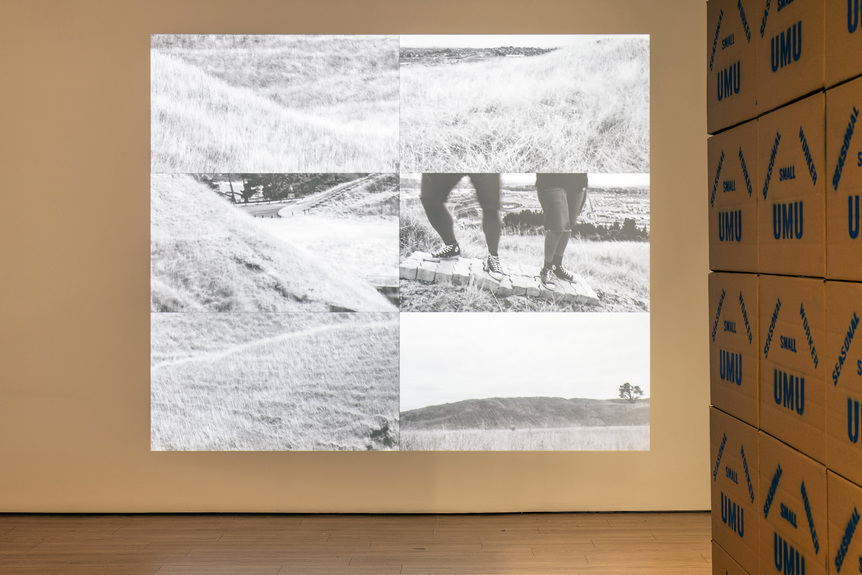-
From Current Issue
-
- Editor’s Letter Fire in the Heart
- Reviews I Gusti Ayu Kadek Murniasih
- Reviews 11th Seoul Mediacity Biennale: “One Escape at a Time”
- Dispatch Networked China
- One on One Monira Al Qadiri on Yukio Mishima
- Essays The rise of independent art spaces in pandemic-era Shanghai
- Features Tuan Andrew Nguyen
- Table of Contents
- Web Exclusives
- Archive
- Subscribe

R
E
V N
E
X
T
Partial installation view of JOHN VEA’s Section 69ZD Employment Relations Act 2000, 2019, participatory installation, dimensions variable, at “If I pick your fruit, will you put mine back?,” 4A Centre for Contemporary Asian Art, Sydney, 2019. Commissioned by 4A. All photos by Kai Wasikowski for 4A; courtesy the artist.
If I pick your fruit, will you put mine back?
John Vea
Migrant labor is a fact of life in the Asia Pacific. In recent years, the voices of migrant workers have been brought to the fore in exhibitions such as “Afterwork” (2016) at Para Site, Hong Kong, and Arin Rungjang’s “They Beat Your Father” (2019) at ShanghArt Singapore. While the domestic workers and construction laborers featured in these shows have a particular visibility in their host cities, fruit-pickers who come to Australia or New Zealand via seasonal worker schemes are relatively invisible.
Auckland-based artist John Vea builds his practice around the experiences of Pacific migrants. Working in regional locations on short-stay visas that require them to depart immediately upon completion of their jobs, these laborers lead an unstable existence. Vea’s exhibition at the 4A Centre for Contemporary Asian Art was already in development when Australia’s deputy prime minister Michael McCormack responded in August to criticism from Pacific Island leaders that Australia was ignoring the threat of climate change to that region by stating, “They will continue to survive because many of their workers come here and pick our fruit.” Vea’s seeming retort in the title “If I pick your fruit, will you put mine back?” set the tone for the exhibition, which employed ironic and ultimately absurd gestures to explore the social, political, and environmental implications of these worker schemes.
For Vea’s exhibition, the glass frontage of 4A (which usually showcases the downstairs gallery space) displayed the reverse of a set. On the other side was Section 69ZD Employment Relations Act 2000 (2019), an installation based on the plastic-furnished breakrooms common to the workplaces of many so-called low-skilled laborers, including the New Zealand packing company where Vea once worked.
Installation view of JOHN VEA’s (foreground) seasonal worker survival kit, 2015–, mixed-media installation, dimensions variable; and (background) 29.09.09 Tribute to Samoa, American Samoa and Tonga, 2013, video: 30 min 38 sec, at “If I pick your fruit, will you put mine back?,” 4A Centre for Contemporary Asian Art, Sydney, 2019.
Upstairs, an imposing stack of cardboard boxes titled seasonal worker survival kit (2015– ), changed visitors’ usual course. These immediate displacements gestured at the precarious situations of workers. Reminiscent of Andy Warhol’s Brillo Boxes, the umu cartons, often used by Pacific migrants to take food cooked in a traditional earth oven with them on flights, remind us that with the arrival of workers from foreign shores, a country also receives cultural practices and knowledge.
Vea’s Trojan horse tactics were also on show in a parallel program, part of Performance Space’s Liveworks Festival of Experimental Art, which saw Vea present a pop-up booth imitating those designed to attract workers from Pacific nations to sign up as fruit pickers abroad. At the booth, set up adjacent to the venue’s weekly farmers market, Vea initiated conversations around the issue, and shared oranges bearing stickers detailing the minimum wage and visa stipulations of the workers who picked the fruit.
While Vea treaded lightly with his message in the Liveworks performance, the video works at his 4A exhibition find him physically weighed down, making visible the hard labor that was alluded to in the installations and performance. In the six-channel Concrete is as concrete doesn’t (2017), Vea and a friend can be seen traversing a landscape using a path created from pavers that the pair continually replace in front of them. The artist is shown holding a large rock across five screens in Finish this week off and that’s it! (2014), filmedover a five-week period during which he lived on the global poverty line. And in 29.09.09 Tribute to Samoa, American Samoa and Tonga (2013), a work made in response to the disastrous 2009 Samoa earthquake and tsunami, Vea battles nature in an attempt to build a wall from breezeblocks in the surf. Less didactic than the installations and performance, the video works take their beginnings in the same issues but transcend them, becoming powerful gestures of human resilience. Ultimately, Vea’s exhibition succeeded in striking a balance between conversation and confrontation, while giving voice to the anonymous.
John Vea’s “If I pick your fruit, will you put mine back?” is on view at 4A Centre for Contemporary Asian Art, Sydney, until December 15, 2019.
To read more of ArtAsiaPacific’s articles, visit our Digital Library.










